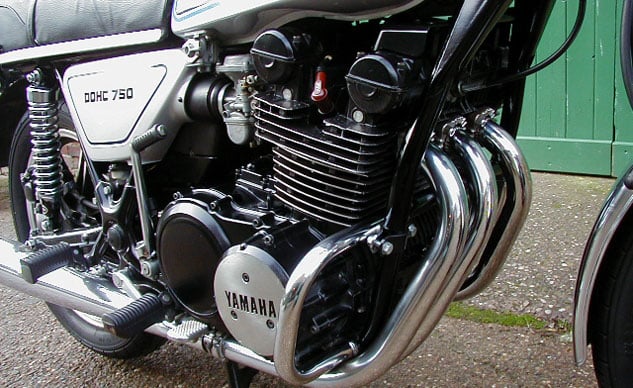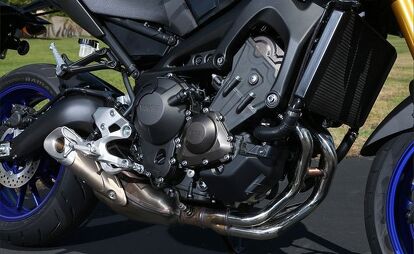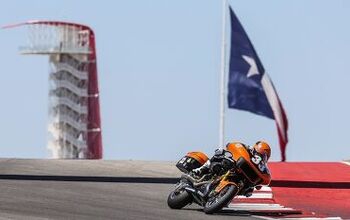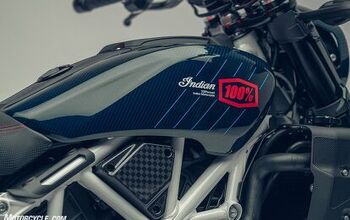Yamaha Triples Retrospective

To appreciate the future, you must understand the past
If you’ve ever read or watched one of our Triumph reviews, you’ve undoubtedly seen us wax poetic about the lovely three-cylinder engines. Triples seem to perfectly blend the torquey nature of V-Twins with the high-revving excitement of four-cylinders, with a wonderful exhaust melody to boot. With MV Agusta entering its own Triples into the market, the available options for three-cylinder fun have only grown larger and we’re all the happier for it.
Now Yamaha has released its latest Triple, the FZ-09, with sights set on grabbing a piece of this three-cylinder pie. The tuning fork company is looking to shake up the relatively bland motorcycle scene coming out of Japan. The FZ-09’s imminent arrival just might be the catalyst the industry needs.
Visit our Yamaha FZ-09 Forum
Time for a history lesson
To fully appreciate the next wave of Japanese Triples, we need to look back at the last time Yamaha had a go with three cylinders. We’re talking the XS750 and later the XS850.
The origins for these two bikes share a similar plot line with the FZ-09. In 1976, in an attempt to introduce something new, exciting and different in the age of the four-cylinder Kawasaki Z1 and Honda CB750, Yamaha introduced the XS750. Its three-cylinder layout was distinctive and its exhaust note equally lovely as modern Triples (seriously, search Youtube for XS750 to hear what I’m talking about), but it was by no means the highest performer of its time.
Read our Triumph Street Triple R Review
Still, in the July 1976 issue of Cycle magazine, its testers were pleasantly surprised at the engine’s utter smoothness, a trait atypical of Triples of the time. The iron block carried a forged steel crank with two-piece connecting rods and plain bearings. The dual overhead cams were chain driven, and 34mm Mikuni carburetors metered the air/fuel ratio.
Power was transmitted through a five-speed gearbox and ultimately a shaft drive to the rear wheel. Contributing to the smooth ride was Yamaha’s choice to utilize CV U-joints at the swingarm pivot point instead of the typical (and cheaper) Hooke joints of the time. A feature seen on many shaft-driven motorcycles today, CV U-joints allowed the swingarm to pivot up and down without affecting the power delivery to the rear wheel.
The XS750, while unique among its competition, was engineered with reliability in mind and was never the horsepower king amongst its rivals, especially the Kawasaki Z1. Still, it found a place in people’s hearts for different reasons.
Ride quality was impressive for its time, and the twin rear shocks featured five-position preload adjustability. The telescopic fork was adjustable three ways. Sounds rather rudimentary today, but by 1976 standards the XS750 handled rather well. A major issue affecting handling is fork stiction, or the stanchions not compressing or rebounding smoothly after a jolt. The 750 seemed to solve those issues, providing a surprisingly compliant ride. It, along with the distinctive engine, made the XS750 a collectible bike today.
Behold the XS850
Horsepower is king, as the saying goes, and eventually Yamaha couldn’t ignore the fact customers were wishing for more of it. So in 1979 the XS850 was introduced. Don’t let the name fool you: the 850 was actually 826cc thanks to a 3.5mm larger bore. Still, it was the bigger Triple people were asking for. The development behind the XS850 wasn’t as simple as just increasing bore; an entirely new cylinder head was developed along with numerous other internal tweaks to compensate for the bigger pistons.
As the motorcycle industry entered the 1980s, concern for Mother Earth, and the internal combustion engine’s degradation of it, started to rise. Because of this EPA crackdown for cleaner burning engines, Yamaha turned to Hitachi, not Mikuni, to outfit the XS850 with carbs jetted incredibly lean. This combined with a very restrictive muffler and complicated air intake plumbing meant the 850 pleased the sniff test, but performance took a dive.
Of course, once the bikes went into private hands, bigger jets (or a whole carb swap), cleaner intake routing and free-flowing exhausts quickly fixed this power issue and negated any stride to help the environment. One thing that didn’t need touching was the suspension. The 850s continued where the 750 left off, introducing air forks to complement the adjustable shocks.
Read our MV Agusta Brutale 800 Review
A common feature on some cruiser shocks today, the air forks work in a similar fashion. Increasing or decreasing air pressure within the fork tube helps determine the stiffness of the front end. The system had its quirks, but overall it delivered a good ride. Combined with its capable chassis canyon runs became an exciting task. Rubber mounted handlebars and engine mounts, coupled with a cushy seat, meant vibes were all but non-existent.
In its 1979 review, Cycle again touted the virtues of the XS850, calling it an “excellent” motorcycle, followed by “If it is not terrifically fast, then it definitely is fast enough, and it’s smooth, good-handling and has powerful brakes and most of the comforts of home.”
What the future holds
We now come back full circle to the FZ-09. Introduced at a time when the conservative Japanese motorcycle industry is seemingly playing catch-up to the aggressive and bold European OEMs, Yamaha’s latest Triple seeks to achieve what the XS750 and XS850 did over 30 years ago — spark some life back into the field, and at an affordable price.
Coming in under eight grand at $7990, the FZ-09, which we briefly covered here is not only aiming to steal the show from the likes of Honda’s CB1000R and Kawasaki’s Z1000, but Triumph and MV Agusta as well. The chart below provides some interesting data we can use to compare and contrast the XS to the FZ.
At 847cc, the FZ-09 has a 10mm larger bore than the XS750 (78.0mm vs. 68.0), but its stroke is much shorter at 59.1mm (vs. 68.6mm). The new bike is also liquid-cooled, as opposed to the air-cooled XS engines. With four valves per cylinder, the FZ gets double the amount of valves at 12, while compression is also considerably higher at 11.5:1. Carburetors have given way to electronic fuel injection.
Obviously, with almost 40 years separating the first XS750 from the new FZ-09, many things have changed. Suspensions have advanced, materials have improved and of course engine technology has progressed. Perhaps where we see these advancements the most is in the curb weights given by Yamaha. Despite the bigger engine, wider wheels and tires, and the fitment of EPA-approved emissions systems, Yamaha says the FZ-09 tips the scales at a slim 414 lbs., ready to ride. The XS850 is a whopping 150 lbs heavier. That’s like carrying a pillion with you on every ride.
On paper, the FZ-09 looks to be an enjoyable machine. Its specs are impressive, but beyond that, Yamaha’s history in building three-cylinder motorcycles should shine through once we throw a leg over it. It may not light the world on fire, but it could be just the jolt the Japanese OEMs need to bring to market cool, interesting and affordable motorcycles.
We’ll be attending the press introduction for the FZ-09 later this week in San Francisco. Be sure to catch our full review from the intro early next week.
Yamaha Triples Comparison
| 1976 Yamaha XS750D | 1979 Yamaha XS850 | 2014 Yamaha FZ-09 | |
|---|---|---|---|
| Engine | 747cc air-cooled DOHC 4-stroke triple; 6 valves | 826cc air-cooled DOHC 4-stroke triple; 6 valves | 847cc liquid-cooled DOHC 4-stroke triple, 12 valves |
| Bore x Stroke | 68.0 x 68.6mm | 71.5 x 68.6mm | 78.0 x 59.1mm |
| Compression | 8.5:1 | 9.2:1 | 11.5:1 |
| Fuel Delivery | 3x 34mm Mikuni Carburetors | 3x 34mm Hitachi Carburetors | Fuel Injection |
| Transmission | 5 Speed, shaft drive | 5 Speed, shaft drive | 6-speed; multiplate wet clutch, chain drive |
| Front Suspension | Telescopic forks, 6.9-in wheel travel | Telescopic forks, 6.9-in wheel travel | 41mm fork; adjustable preload and rebound damping; 5.4-in travel |
| Rear Suspension | Twin shocks, 4.0-in travel | Twin shocks, 3.9-in travel | Single shock; adjustable preload and rebound damping; 5.1-in travel |
| Front Brakes | Twin 267mm discs, 1 piston caliper | Twin 267mm discs, 1 piston caliper | Dual hydraulic disc, 298mm |
| Rear Brakes | Single 267mm disc, 1 piston caliper | Single 267mm disc, 1 piston caliper | Hydraulic disc, 245mm |
| Front Tire | 100/90-19 | 100/90-19 | 120/70-ZR17 |
| Rear Tire | 110/90-18 | 110/90-18 | 180/55-ZR17 |
| Length | 85.0 in | 85.6 in | 81.7 in |
| Width | 38.0 in | 35.4 in | 32.1 in |
| Height | 46.7 in | 46.9 in | 44.7 in |
| Seat Height | 31.9 in | 31.5 in | 32.1 in” |
| Wheelbase | 57.7 in | 57.1 in | 56.7 in |
| Rake | 27.0° | 27.0° | 25.0° |
| Curb Weight | 552 lbs | 564 lbs | 414 lbs |
| Fuel Capacity | 4.5 gal | 4.5 gal | 3.7 gal |

Troy's been riding motorcycles and writing about them since 2006, getting his start at Rider Magazine. From there, he moved to Sport Rider Magazine before finally landing at Motorcycle.com in 2011. A lifelong gearhead who didn't fully immerse himself in motorcycles until his teenage years, Troy's interests have always been in technology, performance, and going fast. Naturally, racing was the perfect avenue to combine all three. Troy has been racing nearly as long as he's been riding and has competed at the AMA national level. He's also won multiple club races throughout the country, culminating in a Utah Sport Bike Association championship in 2011. He has been invited as a guest instructor for the Yamaha Champions Riding School, and when he's not out riding, he's either wrenching on bikes or watching MotoGP.
More by Troy Siahaan









































Comments
Join the conversation
This article is erroneous. The first Yamaha triple came out in about 74, it was a turd and had to be pulled off the market. When they came back with it, it was perfect.
I almost bought an 850 triple at Kenny's in the mid 80s. It was a non current model and I think the price was only like $1800. Seemed like a great deal at the time. But, the one I wanted was dressed as a tourer, with fairing and bags. I've never seen another one. I thought it was a factory bike but maybe not. Don't know why the dealership would install so many extras on a bike they were selling so cheap. Has anybody else ever seen one?